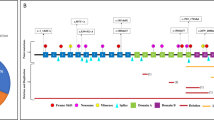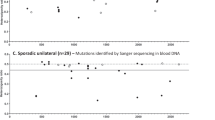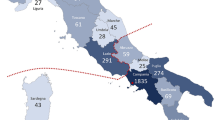Abstract
RB1 is the gene responsible for retinoblastoma, the most common malignant intraocular tumor of infancy and early childhood. There are no reports about this gene in Ecuadorian populations, and only a few studies have been published in Latin America about this subject. There is a spectrum of more than 370 mutations described in the RB1 gene mutation database (http://www.d-lohmann.de/Rb/mutations.html), and alterations have been found in 25 of the 27 exons. During the exon-by-exon analysis of 31 tumor and blood samples from Ecuadorian patients, we found two new mutations and three novel polymorphisms. One of the polymorphisms is located in intron 26 where no alterations of the gene have been described previously. The polymorphisms were found in all of the patients’ tumor samples, but not in normal population, suggesting there might be a relationship between these polymorphisms and the development of retinoblastoma in the Ecuadorian population.
Similar content being viewed by others
Introduction
Retinoblastoma is a childhood malignant eye tumor arising from the retina. According to Knudson’s hypothesis, it is a cancer caused by two mutational events (Knudson, 1971). Approximately 40% of retinoblastoma patients are hereditary cases and have bilateral tumors, while the other 60% are sporadic cases and present unilateral tumors (Vogel, 1979). Mutations in the RB1 gene (MIM# 180200) are responsible for the development of this malignancy. Patients with the hereditable form of retinoblastoma are highly susceptible to the development of other non-ocular cancers, such as osteosarcomas, melanomas, and brain tumors (Eng et al., 1993). A molecular analysis of the gene is important to determine its origin and to give an accurate genetic counseling as well as to understand the different mechanisms involved in the development of this tumor. Few reports exist in South America about the retinoblastoma gene (Szijan et al., 1995; Rodriguez et al., 2002), and to our knowledge, there are no previous studies on this subject in Ecuadorian patients.
Subjects and methods
We studied 31 unrelated patients diagnosed with retinoblastoma by ophthalmologic and histological examinations; 23 were unilateral cases and 8 were bilateral. DNA was extracted from paraffin-embedded enucleated tumors and whole blood samples from 31 patients. Genomic DNA was amplified by the polymerase chain reaction (PCR) using primers specific for exons 1–27 (sequences available upon request). Primers were designed to overlap intronic sequences of 20–40 nucleotides at both sides of the corresponding exons and were tailed at the 5’ end with the sequence of M13Rev and –21M13 sequencing primers, respectively, in order to allow for direct sequencing.
The reaction mix contained 200 μM each dNTP, 10 μM of each primer, 100 ng of genomic DNA, 2.5 U Taq Gold polymerase (PE Biosystems), 2 μl 10X reaction buffer (PE Biosystem, Foster City, CA, USA), and 1.5 mM MgCl2 in a final volume of 20 μl. The cycling conditions were an initial denaturation step at 94°C for 10 min followed by 10 cycles each composed of a 1 min denaturation step at 94°C, a 30 s annealing step at 53°C, and a 45 s extension step at 72°C; then 30 cycles composed of 30 s at 94°C, 30 s at 55°C, and 45 s at 72°C. The reaction was completed with a final extension step at 72°C for 10 min. One microliter of each PCR product was sequenced with 4 μl of the ABI PRISM Big Dye Primer cycle sequencing ready reaction kit (PE Biosystem) and analyzed on a ABI PRISM 377 DNA sequencer.
Results and discussion
During the exon-by-exon analysis, two novel mutations of the RB1 gene were identified. One is a missense mutation (Fig. 1A) in exon 15 due to a single G-to-A substitution (g.76920 G>A) that predicted a serine for asparagine substitution at amino acid 474, which is located within the pocket domain like most of the missense mutations in the RB1 gene. In previous studies, families with low-penetrance retinoblastoma present missense mutations (Onadim et al., 1992; Lohmann et al., 1994; Cowell and Bia, 1998), and since this mutation was found in the tumor sample and not in the blood sample of a unilateral retinoblastoma with no familial history, the likelihood of disease for his offspring is very low.
The other new mutation is a T-to-C substitution at –14 in the splicing site 5’ in intron 22 (g.IVS22–14 T>C) (Fig. 1B) found in the tumor and whole blood sample from a unilateral retinoblastoma. Since 15–17% of unilateral retinoblastomas have a germline origin (Lohmann et al., 1997) and the mutation is present in the patient’s DNA, he has a higher risk to develop secondary neoplasms (Eng et al., 1993; Horsthemke, 1992) and needs a closer monitoring.
The authors consider that the lower mutation rate of this study compared with previous mutation search studies of RB1 gene (Lohmann et al., 1996) is due to the low quality of DNA extracted from paraffin-embedded tumors, which was an obstacle for PCR amplification of several exons; the mutation rate of this study was 30%, which is similar to other studies (Cowell et al., 1994; Blanquet et al., 1995). We consider that the mutation responsible for the retinoblastoma in those patients was located in the nonsequenced exons. This reflects the difficulties in mutation analysis of large genes with an extensive mutational heterogeneity (Lohmann et al., 1996).
In the course of this study, we also found three novel polymorphisms. Two are deletions of a single base delT at position –18 in intron 15 (g.76983) SNP1, and delT at –19 in intron 16 (g.78064) SNP2. The third SNP3 is a C>T transition at g.174438 in intron 26. All the 31 patients presented the variant SNP1 and SNP3, and for the variant SNP2, the frequency was 0.66. This is the first report of a polymorphism in intron 26 in the retinoblastoma gene.
These three polymorphisms were not found in the normal population of 100 unrelated healthy Ecuadorian people (data not shown), suggesting that these variants could be associated with the retinoblastoma phenotype. This finding represents an important contribution to the molecular diagnosis of retinoblastoma in our country and an important tool for genetic counseling.
References
Blanquet V, Turleau C, Gross-Morand M.S, Sénamaud-Beaufort C, Doz F, and Besmond C (1995) Spectrum of germinal mutations in the Rb1 gene: a study of 232 patients with hereditary and non hereditary retinoblastoma. Hum Mol Genet 4:383–388
Cowell JK, Bia B (1998) A novel missense mutation in patients from a retinoblastoma pedigree showing only mild expression of the tumor phenotype. Oncogene 16:3211–3213
Cowell JK, Smith T, Bia B (1994) Frequent constitutional C to T mutations in CGA-arginine codons in the RB1 gene produce premature stop codons in patients with bilateral (hereditary) retinoblastoma. Eur J Hum Genet 2:281–290
Eng C, Li FP, Abramson DH, Ellsworth RM, Wong FL, Goldman MB, Seddon J, Tarbell N, Boice JD Jr (1993) Mortality from second tumors among long-term survivors of retinoblastoma. J Natl Cancer Inst 85:1121–1128
Horsthemke, B (1992) Genetics and cytogenetics of retinoblastoma. Cancer Genet Cytogenet 63:1–7
Knudson AGJ (1971) Mutation and cancer: statistical study of retinoblastoma. Proc Natl Acad Sci USA 68:820–823
Lohmann DR, Brandt B, Hopping W, Passarge E, Horsthemke B (1994) Distinct RB1 gene mutations with low penetrance in hereditary retinoblastoma. Hum Genet 94:491–496
Lohmann DR, Brandt B, Hopping W, Passarge E, Horsthemke B (1996) Spectrum of Rb1 germline mutations in hereditary retinoblastoma. Am J Hum Genet 58:940–949
Lohmann DR, Gerick M, Brandt B, Oelschläger U, Lorenz B, Passarge E, Horsthemke B (1997) Constitutional Rb1-gene mutations in patients with isolated unilateral retinoblastoma. Am J Hum Genet 61:282–294
Onadim Z, Hogg A, Baird PN, Cowell JK (1992) Oncogenic point mutations in exon 20 of the RB1 gene in families showing incomplete penetrance and mild expression of the retinoblastoma phenotype. Proc Natl Acad Sci USA 89:6177–6188
Rodriguez M, Salcedo M, Gonzalez M, Coral-Vazquez R, Salamanca F, Arenas D (2002) Identification of novel mutations in the RB1 gene in Mexican patients with retinoblastoma. Cancer Genet Cytogenet 138(1):27–31
Szijan I, Lohmann DR, Parma DL, Brandt B, and Horsthemke B (1995) Identification of RB1 germline mutations in Argentinian families with sporadic bilateral retinoblastoma. J Med Genet 32:475–479
Vogel F (1979) Genetics of retinoblastoma. Hum Genet 52:1–54
Acknowledgments
This work was supported by grants from: Programa de Cooperación Científica con Iberoamérica (B.O.E. 29-II-00), and Proyecto Fundación para la Ciencia y Tecnología (FUNDACYT) PUCE #29. We are indebted to Dr. Enrique Hermida (Hospital Metropolitano), Dr. Dolores Franco (Hospital de Niños Baca Ortiz), and Dr. Gregorio Gabela (Hospital Eugenio Espejo) for the samples.
Author information
Authors and Affiliations
Corresponding author
Additional information
The nucleotide sequence data reported are available in the GenBank database under the accession numbers: AY243567, AY260472, AY260473, AY273783
Rights and permissions
About this article
Cite this article
Leone, P.E., Vega, M.E., Jervis, P. et al. Two new mutations and three novel polymorphisms in the RB1 gene in Ecuadorian patients. J Hum Genet 48, 639–641 (2003). https://doi.org/10.1007/s10038-003-0092-5
Received:
Accepted:
Published:
Issue Date:
DOI: https://doi.org/10.1007/s10038-003-0092-5
Keywords
This article is cited by
-
Retinoblastoma genetics screening and clinical management
BMC Medical Genomics (2021)




